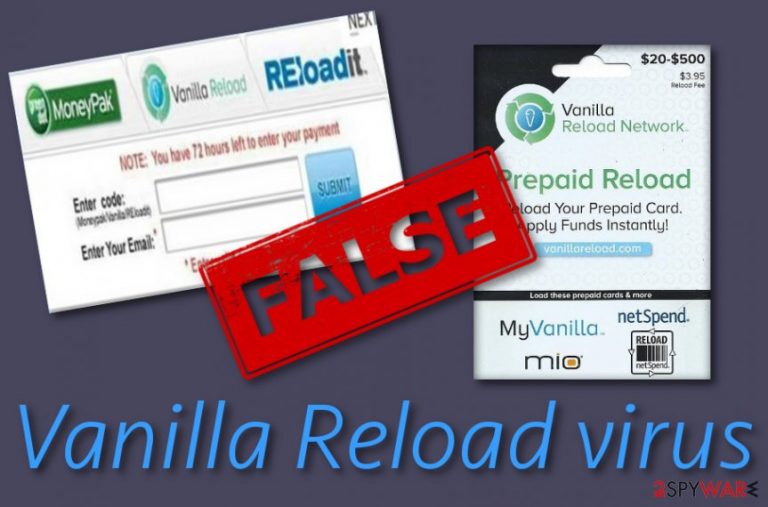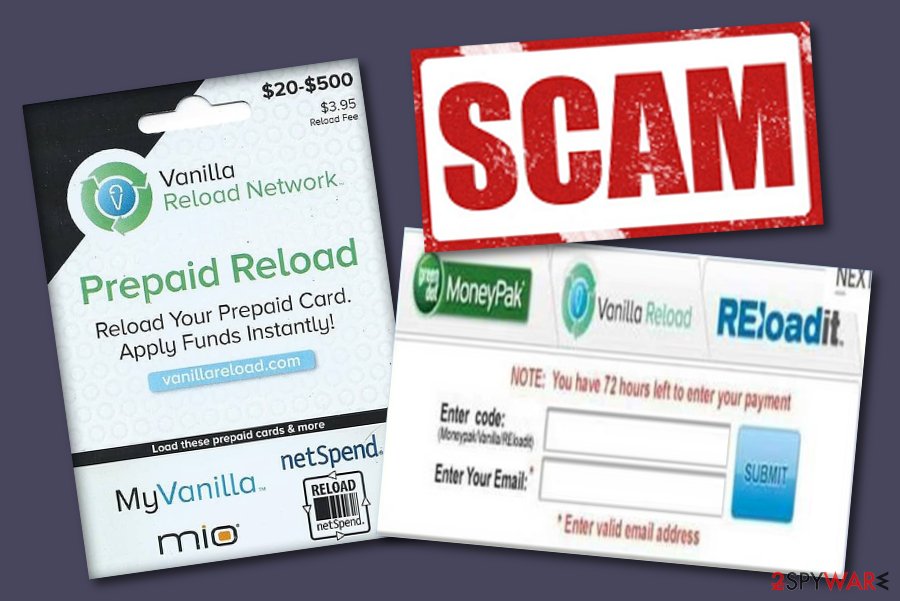Vanilla Reload virus (Removal Guide) - updated Jul 2019
Vanilla Reload virus Removal Guide
What is Vanilla Reload virus?
Vanilla Reload virus – a scam campaign that includes several versions

Vanilla Reload virus is a scam app[1] that is closely related to a legitimate and well-known online payment system called Vanilla Reload. This service can be used for making online purchases and payments without a credit card. We believe that this feature was the one that made cybercriminals to choose this service for collecting their illegal ransom fees. If Vanilla Reload virus infects the system, it locks it down and starts showing a huge warning message asking to pay a ransom via MoneyPak, Vanilla Reload, and RELoadit prepayment systems.
Similarly to FBI virus, Ukash virus, Moneypak virus, REloadit virus, Metropolitan Police virus, PRISM virus, and other malware, Vanilla Reload virus gives a reason why it blocked the system and disabled the access to PC's desktop and Start Menu. In most of the cases, it informs its victims about their illegal online activities, such as the use of copyrighted content, distribution of malware, visiting illegal websites and similar.
| Name | Vanilla Reload |
|---|---|
| Type | Scam |
| Versions | 5 different variants that push fake offers of prizes, rewards, channel upgrades, etc. |
| Similarities | The scam might be similar to other threats such as PRISM virus, FBI virus, Ukash virus, etc. |
| Payment versions | Crooks suggest transferring money to them via MoneyPak, Vanilla Reload, and RELoadit |
| Aim | To gather as much monetary income as possible |
| Distribution | Email spam, suspicious networks, etc. |
| Removal | Use FortectIntego to detect malicious objects, and get rid of the scam automatically |
Mostly, scams such as Vanilla Reload appear on third-party networks but sometimes a malicious infection might be lurking in your computer and producing such type of content straight to your desktop. Once the misleading notification appears, scammers pretend to be from law enforcement agencies and add the logo of various police departments to the message just to create a legitimate look.
If you notice an alert asking you to make a payment through this financial system, there might be a possibility that your computer was infected with some type of malware. Please, do NOT pay any fine. Just remove Vanilla Reload virus from the system. For that, you can use a guide that is given at the end of the article. Also, you can download FortectIntego to fix any possible damage to your machine.
Furthermore, it is known that Vanilla Reload virus has more than one variant released out in the wild. One popular variant of the scam claims that the user's computer and data were blocked due to some type of illegitimate activity performed. To avoid prosecution or other penalties, the victim is demanded to pay a $100 fine via Vanilla Reload, MoneyPak or similar services that ensure the anonymity of the process:
All activities of this computer has been recorded. All your files are encrypted. Don’t try to unlock your computer! This PC is blocked due to at Least one of the specified below. […]
The first violation may not entail the criminal liability if the payment of the fine in connection with the law of loyalty of people. on 26 January 2013. In repeated violations of criminal responsibility is inevitable.
To unlock your computer and avoid other legal consequences, you are obligated to pay a release fee of $100.
Vanilla Reload virus removal is a necessary process as the scam might carry malware somewhere and you can accidentally step on the malicious content and end up with severe system damage. Even though this does not mean that it will definitely happen but you should not take such risks and get rid of the scamming message in time. Additionally, keep on reading and note what other versions the scam carries.

Vanilla Reload virus. 5 variants for your notice
Vanilla Reload virus appears to be a scam campaign that includes more than one version. Suspicious messages are passed on to various random users by claiming false things about prizes won, buying things on eBay, upgrading the channel number on your television, and similar variants. Take a closer look at these versions:
Channel offering scam
This type of scam is promoted via phone calls. Hackers call potential victims and offer specific channels for $365 per year or $1 per day. As evidence of being located in DirecTV, the caller suggests users watch a free preview of the offered channels. If the user agrees with the terms, he/she is urged to transfer the fee via Vanilla Reload and provided their DirecTV account data. Be careful as sensitive details might easily get exposed and misused for data theft.
Help with money purposes
Hackers use a type of Vanilla Reload scam to promote false loans offers. Scammers seek to make contact with random people and consider all cash-loaning possibilities. As a way to ensure safety, the crooks will supposedly urge you to pay some type of fee before getting the loan that is a way to scam people unknowingly. Note that this type of scam occurs not only with Vanilla Reload but also with Moneypak, Green Dot, and Ukash payment cards.
Prize and lottery wins
This type of Vanilla Reload scam provides users with information about specific prizes, lotteries, or awards won that can be claimed by transferring a 5% fee via Vanilla Reload pay card. Be aware of such scamming content as this is just a way to lure you into making transactions and giving away money for random crooks.
Product paying on eBay and other networks
If you are lured into this scam, you will discover items on sell on websites such as eBay, Gumtree, and Craiglist for which money needs to be transferred via the Vanilla Reload payment method. However, if you provide your credit/debit card details to confirm the payment, the scammers will supposedly enter your banking card immediately and you might be left with enormous monetary losses.
Extra credit to your card
Another type of scam that offers to purchase Vanilla Reload debit cards and fill them up with money. However, the scammer asks providing him/her with the PIN of the debit card to complete the cash transferring process. If you do that, the hackers will be able to get all of the money that is stored on the card.

Scam appearance on computers
Scam and malware with it can get inside your computer via lots of different methods. It can easily infiltrate your PC system after downloading an infected email's attachment or after visiting an infected website. In addition, this virus has also been spread via fake alerts that are typically set to 'inform' people about outdated programs and then offer them to download these updates for free.
Of course, you should never click such alert because you can never know what 'update' can be downloaded on your computer after that. If you think that some of your programs are outdated, go to their official websites and download them. Of course, you should also make sure that your computer is protected by reliable and up-to-date anti-spyware that could help you to prevent the installation of the virus.
According to experts from LosVirus.es,[2] the best combination of full computer security would be the manual and automatical methods used together. You should keep an eye on your Internet activity and computing work performed while the anti-malware will complete malware scans and warn you if something wrong has been going on lately.
Remove Vanilla Reload virus and all additional content
If you think that your PC was affected by the scam and additional malware,[3] you should waste no time and get rid of it because there is no other way to recover the connection to your desktop and files. For that, you should firstly regain the access to our computer and just then remove Vanilla Reload virus with all of the malicious components it might have brought to the system.
In order to check if the scam has brought some malware or has been caused by a dangerous threat, you should check the entire system with anti-malware software such as FortectIntego, SpyHunter 5Combo Cleaner, or Malwarebytes. When scan results are provided to you, you can successfully continue with Vanilla Reload removal. Additionally, if your screen has been blocked and you are not able to access it anymore, use the following boot options to regain proper activity on your computer.
Getting rid of Vanilla Reload virus. Follow these steps
Manual removal using Safe Mode
Use this method to boot your computer to Safe Mode with Networking and deactivate all malicious processes:
Important! →
Manual removal guide might be too complicated for regular computer users. It requires advanced IT knowledge to be performed correctly (if vital system files are removed or damaged, it might result in full Windows compromise), and it also might take hours to complete. Therefore, we highly advise using the automatic method provided above instead.
Step 1. Access Safe Mode with Networking
Manual malware removal should be best performed in the Safe Mode environment.
Windows 7 / Vista / XP
- Click Start > Shutdown > Restart > OK.
- When your computer becomes active, start pressing F8 button (if that does not work, try F2, F12, Del, etc. – it all depends on your motherboard model) multiple times until you see the Advanced Boot Options window.
- Select Safe Mode with Networking from the list.

Windows 10 / Windows 8
- Right-click on Start button and select Settings.

- Scroll down to pick Update & Security.

- On the left side of the window, pick Recovery.
- Now scroll down to find Advanced Startup section.
- Click Restart now.

- Select Troubleshoot.

- Go to Advanced options.

- Select Startup Settings.

- Press Restart.
- Now press 5 or click 5) Enable Safe Mode with Networking.

Step 2. Shut down suspicious processes
Windows Task Manager is a useful tool that shows all the processes running in the background. If malware is running a process, you need to shut it down:
- Press Ctrl + Shift + Esc on your keyboard to open Windows Task Manager.
- Click on More details.

- Scroll down to Background processes section, and look for anything suspicious.
- Right-click and select Open file location.

- Go back to the process, right-click and pick End Task.

- Delete the contents of the malicious folder.
Step 3. Check program Startup
- Press Ctrl + Shift + Esc on your keyboard to open Windows Task Manager.
- Go to Startup tab.
- Right-click on the suspicious program and pick Disable.

Step 4. Delete virus files
Malware-related files can be found in various places within your computer. Here are instructions that could help you find them:
- Type in Disk Cleanup in Windows search and press Enter.

- Select the drive you want to clean (C: is your main drive by default and is likely to be the one that has malicious files in).
- Scroll through the Files to delete list and select the following:
Temporary Internet Files
Downloads
Recycle Bin
Temporary files - Pick Clean up system files.

- You can also look for other malicious files hidden in the following folders (type these entries in Windows Search and press Enter):
%AppData%
%LocalAppData%
%ProgramData%
%WinDir%
After you are finished, reboot the PC in normal mode.
Remove Vanilla Reload using System Restore
Complete the following to activate System Restore and regain proper access to your system and software:
-
Step 1: Reboot your computer to Safe Mode with Command Prompt
Windows 7 / Vista / XP- Click Start → Shutdown → Restart → OK.
- When your computer becomes active, start pressing F8 multiple times until you see the Advanced Boot Options window.
-
Select Command Prompt from the list

Windows 10 / Windows 8- Press the Power button at the Windows login screen. Now press and hold Shift, which is on your keyboard, and click Restart..
- Now select Troubleshoot → Advanced options → Startup Settings and finally press Restart.
-
Once your computer becomes active, select Enable Safe Mode with Command Prompt in Startup Settings window.

-
Step 2: Restore your system files and settings
-
Once the Command Prompt window shows up, enter cd restore and click Enter.

-
Now type rstrui.exe and press Enter again..

-
When a new window shows up, click Next and select your restore point that is prior the infiltration of Vanilla Reload. After doing that, click Next.


-
Now click Yes to start system restore.

-
Once the Command Prompt window shows up, enter cd restore and click Enter.
Finally, you should always think about the protection of crypto-ransomwares. In order to protect your computer from Vanilla Reload and other ransomwares, use a reputable anti-spyware, such as FortectIntego, SpyHunter 5Combo Cleaner or Malwarebytes
How to prevent from getting malware
Choose a proper web browser and improve your safety with a VPN tool
Online spying has got momentum in recent years and people are getting more and more interested in how to protect their privacy online. One of the basic means to add a layer of security – choose the most private and secure web browser. Although web browsers can't grant full privacy protection and security, some of them are much better at sandboxing, HTTPS upgrading, active content blocking, tracking blocking, phishing protection, and similar privacy-oriented features. However, if you want true anonymity, we suggest you employ a powerful Private Internet Access VPN – it can encrypt all the traffic that comes and goes out of your computer, preventing tracking completely.
Lost your files? Use data recovery software
While some files located on any computer are replaceable or useless, others can be extremely valuable. Family photos, work documents, school projects – these are types of files that we don't want to lose. Unfortunately, there are many ways how unexpected data loss can occur: power cuts, Blue Screen of Death errors, hardware failures, crypto-malware attack, or even accidental deletion.
To ensure that all the files remain intact, you should prepare regular data backups. You can choose cloud-based or physical copies you could restore from later in case of a disaster. If your backups were lost as well or you never bothered to prepare any, Data Recovery Pro can be your only hope to retrieve your invaluable files.
- ^ Scam . Computer hope. Free computer help since 1998.
- ^ LosVirus.es. LosVirus. Spyware news and articles.
- ^ Roger A. Grimes. 9 types of malware and how to recognize them. CSO Online. Articles.







